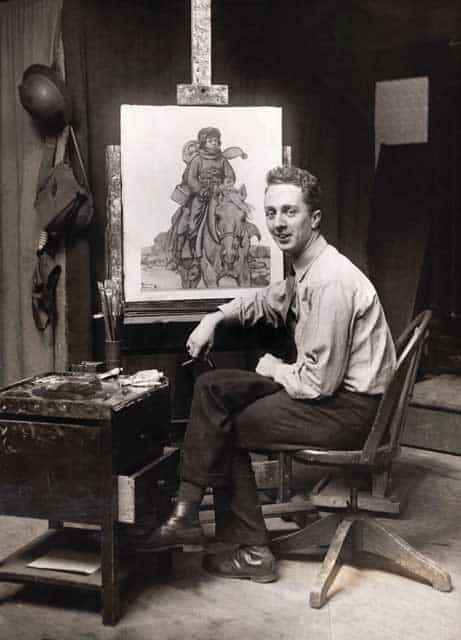Norman Rockwell, Provincetown, and the Creation of a Holiday
by Steve Desroches
A gentle old man plays the fiddle on a fall evening with a grinning, glowing jack o’ lantern at his feet. A little girl dressed as a ghost gives a good-natured scare to a well-dressed man and his dog, who react with playful, exaggerated surprise. A grandfather smoking a pipe carves pumpkins with his grandson, passing on a Halloween tradition as autumn leaves drift in the air around them. These idyllic autumnal images are quintessentially New England, presenting an American life that may seem too good to be true. But it all depends not only on how you look at it, but what you are looking for. Norman Rockwell knew exactly what he was looking for and found it everywhere. Kindness.

Critics and cynics often dismissed Rockwell’s work, not just for technique, but also for subject, often referring to him solely as an illustrator and not an artist. Rockwell was not naпve, nor a blind idealist. His artwork, like that of any artist, was his clear viewpoint and vision. As an artist he so clearly spoke with a declarative voice that his very name is synonymous with American idealism. Norman Rockwell’s paintings may have come from his mind’s eye, but they were also documents of the world around him. Those moments exist. The moments are real. He himself struggled with whether he was an artist or an illustrator, and eventually settled on calling himself a visual storyteller.
“He had a deep understanding of the human psyche,” says Stephanie Plunkett, chief curator of the Norman Rockwell Museum in Stockbridge, Massachusetts. “He chose to paint happiness. He authentically observed people. He observed who we wanted to be. He saw the good in others. These are the moments that even in difficult times were meaningful. He was aware that life was hard and difficult, but that’s not what he wanted to paint. Humanity is filled with good, too. And that’s what he painted.”

Rockwell may be best remembered for specific works like The Four Freedoms, Rosie the Riveter, and The Problem We All Live With, one of his works addressing the civil rights movement as he painted a little Ruby Bridges on her way to school. But of course, Rockwell was a prolific illustrator with his work gracing the covers of magazines like Country Gentleman, Boy’s Life, and most notably The Saturday Evening Post. The Golden Age of Illustration largely overlapped with the period in American life when magazines were also at their height of popularity and circulation, so millions of Americans saw these images everywhere. From the 1880s until the end of World War II illustrators had enormous influence on American cultural life, and Norman Rockwell was their undisputed superstar.
The heyday of illustration and magazines began during the Gilded Age, a time of enormous economic growth in the United States, which led to the expansion of a large middle class and increased immigration to fill the jobs of a rapid industrialization. That led to greater commercialization, especially around holidays, and not just the holidays, meaning Christmas, but all of them, with money to spend and European immigrants reintroducing Old World customs and traditions to American culture. It’s when Halloween first became big business.
In 1912, the Dennison Manufacturing Company, a paper goods business in Framingham, Massachusetts, began publishing Bogie Books, highly illustrated catalogs selling their Halloween decorations and costumes. Almost immediately the biggest magazines of the day followed suit, creating special illustrations for not just Halloween and Christmas, but for everything from the Fourth of July to Groundhog Day. This popular feature led to a national standard of holiday cultural practices, as it presented once regional and insulated traditions to the entire country by illustrators like Rockwell and his contemporaries like J. C. Leyendecker, Maxfield Parrish, and N.C. Wyeth.

“They had the most popular illustrators do the covers of Saturday Evening Post for the holiday issues,” says Lauren Walker of the National Museum of American Illustration in Newport, Rhode Island. “Readers always looked for who they were going to get to do the holiday covers, as they knew it was going to be good. The issues with holiday covers were always the best sellers.”
A native New Yorker, Norman Rockwell spent much of his adult life in New England, first in Arlington, Vermont, and later in Stockbridge, where he died in 1978 at the age of 84 (and for a time he had a studio above a restaurant owned by Provincetown resident Alice Brock, of Alice’s Restaurant fame). Many local friends and neighbors were models for his work, as was the imagery of New England itself, giving the season of autumn a particular affiliation with the region for its foliage and heavy Celtic influence on the celebration of Halloween. While those more reserved and staid New England towns influenced and suited Rockwell’s demeanor, Provincetown played an important, albeit brief, role in his life and work.
By a young age it was clear he was a talented artist, and he enrolled in art school at only 14. His parents were conservative and overbearing, so much so that when he reached the age of 18 and enrolled in Manhattan’s National Academy of Design and then the Art Students League, they insisted he still live with them and directed most every aspect of his life, both professionally and personally. It was a source of frustration to him. Despite being quiet and timid, he wanted to break free and explore all that life had to offer a young artist, whether his parents approved or not. That proved to be impossible for him in New York City under his parent’s surveillance.
“He had a very structured life,” says Plunkett. “And he was a very dutiful person. His friends from the Art Students League are living this wild, bohemian life down in Greenwich Village and he had to be home by 6:30 for dinner.”

He wanted to cut loose, or at least his definition of it, and he’d heard stories about a place that almost took on mythical proportions for its wild ways: Provincetown. In 1912, at 18, the rather naпve and sheltered Rockwell convinced his parents to let him go to Provincetown to study under Charles Hawthorne. He worked hard here focusing on fine art rather than illustration, a field he was already successful in at that young age. Based on letters and diaries in the archives at the Norman Rockwell Museum, he had an absolute ball in Provincetown and received quite the education, much beyond the classes offered by Hawthorne, says Plunkett, though Rockwell spent much of that summer as a wall flower at the raucous parties and artists’ balls. He very much wanted to return to Provincetown, but both his parents and work demands prevented him from doing so. He did come back to Provincetown periodically much later, most notably for the last time in 1947 when he fulfilled a long promise to judge the costume contest at that summer’s Beaux-Arts Ball. He’d planned to stay the whole summer, but left in mid-July after his wife had a nervous breakdown and he fell off his bike and had to go to the hospital in Hyannis to have his jaw wired shut. It’s clear that that summer of 1912 was something he held onto in his memory for the rest of his life.
“The experience was very invigorating for him,” says Plunkett. “He had a very freeing kind of experience, but he never lost his head.”











